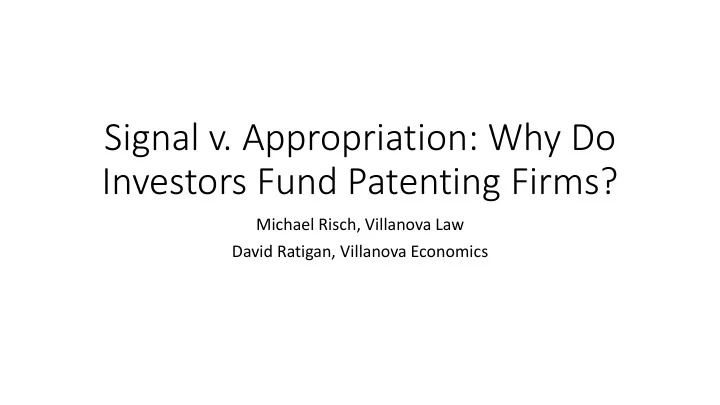

Signal v. Appropriation: Why Do Investors Fund Patenting Firms? Michael Risch, Villanova Law David Ratigan, Villanova Economics
Venture funding • It’s hard out there for a startup • Hard to get funding • High failure rate
• It gets easier…to get funding – if you have a patent • Funding rates go up • But does survival (spoiler from another paper – not necessarily) • Does profits (spoiler from another paper – not necessarily)
But Patents Matter • Why? • Is it because they signal some unobservable characteristics? • Or • Is it because they provide some value in and of themselves?
How do we tell? • A long unanswered question – but an important one • Firms say they get patents first for appropriative value, and then for their ability to attract investments • Investors say they don’t value the appropriative patents • But they heavily weight their investment decisions toward patenting firms • Few have tried to measure the appropriative value • Most use an instrumental variable, which is hard to find
Our Data • Kauffman Firm Survey • Eight year panel of startup firms • Funded/non-funded • Patenting/non-patenting • 3140 at survey start • 1630 survive all eight years • Oversamples on high tech, but representative (and weighted)
Patenting by the KFS Firms
Funding and Profits of the Firms
Patents and Funding
Why Invest? Our Methodology • We are interested in the effect of patenting, other things equal • Many of those other things are observable signals: • Owner experience, credit risk, industry, and other demographic information • But some of the remaining effect is unobservable • Critics contend that this is the “signal” value of patents • Patents are not providing value due to their appropriative value • but instead due to the remaining unobservables
Our Methodology • We net out the unobservable effects by comparing two models • Model I: • Pooled panel regression (compares year to year changes) • Includes time dummy variables • Measures effect of patenting on investment ceteris paribus • Model II: • Fixed effects panel regression, including time dummy variables • Now holds year and firm constant • which means that any unobservable signals are netted out because those will remain the same year after year • What remains in the patent coefficient is the appropriative value of the patent • The ratio between Model I and Model II is the signal to appropriative value
Initial Results • Model I: Patent = 13%*** more likely chance of equity funding • Model II: Patent = .8% more likely chance of equity funding • Interpretation: Zero appropriative effect
Heterogeneity Analysis • There’s a lot of variation in the numbers – maybe something else is driving these results • Industry? • Everyone’s first guess • Turns out, no – same results • Firm Structure? • Yes!
Firm Structure
The Power of General Partnership • Testing by type of entity shows that almost the entire zero result is driven by general partnerships • about 68% less likely to obtain funding than a sole proprietorship in Model II • But only if they have a patent • Why? We have no idea, but only one firm had a patent, so that may be driving the results • The differences are much smaller for C-Corps • These are 5% more likely than sole proprietorships in Model II • and 32% more likely in Model I • This makes the signal to appropriation value a more reasonable 6:1 • For LLCs: • Model I: 11.7%, Model II: -.8% • Perhaps only C-Corps get appropriative value
Even so…
How might our model be wrong? • Maybe appropriation brings more equity quantity? • No – we tested that, with the same results • If there are signals that come and go with years • e.g. patenting is somehow tied to a new CEO in a given year • The time fixed effect solve some of this • If the firms that have dropped out of the survey are somehow different • We measure up to exit • There’s no reason to believe that exit would have affected the investment decision years earlier • If oversampling of high-tech changes the results • We tested with and without weighting, and the results did not change
Recommend
More recommend